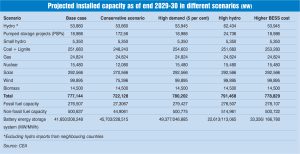
The Central Electricity Authority (CEA) recently released a report on the optimal generation capacity mix for 2029-30. It is a revised version of the Report on the Optimal Generation Capacity Mix for 2029-30, which was released in 2020. The revised version of the report is based on the 20th Electric Power Supply (EPS) report, released in November 2022. It takes into account recent developments and policy changes in the electricity sector at the global and national levels to attain the least-cost optimal generation capacity mix needed to meet the projected peak electricity demand and electrical energy requirement for the year 2029-30.
A state-of-the-art sophisticated generation expansion planning model has been employed to carry out both long-term studies and hourly despatch studies. The report has projected a total installed capacity of around 777 GW in the country in the year 2030 with a battery energy storage capacity of 41 GW. The share of non-fossil-fuel-based sources in the total installed capacity is expected to increase to 64 per cent in 2029-30 from the present level of 42 per cent. Similarly, in terms of gross generation, the share of non-fossil fuel sources is expected to increase to 44 per cent in 2029-30 from 25 per cent in 2022-23.
Power Line presents the key highlights of the optimal generation capacity mix for 2029-30…
Key highlights
The report takes into account the demand forecasts from the 20th EPS report, where the effects of various factors on the country’s future demand was taken into consideration. These factors include the reduction of transmission and distribution losses, energy efficiency improvement measures, green hydrogen production, and penetration of electric vehicles (EVs), rooftop solar and solar pumps.
Demand projections: The estimated all-India peak electricity consumption and electrical energy requirement for 2029-30 is 334.8 GW and 2,279.7 billion units (BUs) respectively, according to the recent 20th EPS forecasts. The uptake of EVs is likely to result in 3 GW peak demand and 15 BUs of energy requirement. The predicted all-India demand that will be met by rooftop solar and solar pump installations in 2029-30 is 34.8 BUs and 2.4 BUs respectively. By 2029-30, it is anticipated that the country will need an additional 250 BUs of energy for the production of green hydrogen, which is expected to reach about 10 million tonnes (mt), considering a load of 5 mt on the grid.
Energy storage capacity: With a storage requirement of 336.4 GWh, including 128.15 GWh from pumped storage projects (PSPs) and 208.25 GWh from battery energy storage systems (BESSs), the required energy storage capacity for 2029-30 is estimated to be 60.63 GW (18.98 GW PSP and 41.65 GW BESS).
Installed capacity: As per the report, the likely installed capacity by the end of the year 2029-30 will be 777,144 MW. This will include 292,566 MW of solar PV capacity, followed by 251,683 MW of coal and lignite, 99,895 MW of wind, 53,860 MW of hydro, 24,824 MW of gas, 18,986 MW of PSP, 15,480 of nuclear, 14,500 MW of biomass and 5,350 MW of small-hydro capacity. There will likely be about 64 per cent of non-fossil-fuel (nuclear, solar, wind, biomass and hydro)-based installed capacity in 2029-30.
Electricity generation: Around 2,440.7 BUs of gross electricity is expected to be produced in 2029-30, of which 1,364.5 BUs will come from thermal sources (coal, gas and lignite), 984 BUs from renewable energy sources (including 222.5 BUs from hydropower), and 92.2 BUs from nuclear power. It is estimated that the percentage of non-fossil fuels in the overall generation of electricity in 2029-30 will be around 44 per cent.
Carbon emissions: A total of 1,002 mt of CO2 was emitted in 2021-22 compared to 910 mt in 2020-21. In 2029-30, it is projected that the power sector will emit 1,114 mt of CO2. By the year 2029-30, the average emission factor is projected to decrease to 0.477 kg CO2 per kWh net.
Projected coal requirement: The report notes that the expected gross generation from coal- and lignite-based power plants for 2029-30 is 1,515.82 BUs. The estimate includes a likely increase in coal-based generation due to uncertainty in the realisation of anticipated or planned capacity addition from hydro, nuclear, variable renewable energy sources, and/or climatic factors such as drought. The resultant coal requirement for the year 2029-30 is estimated at 1,019.6 mt considering a specific coal consumption of 0.666 kg per kWh plus 1 per cent transportation loss.
PLF of coal-based power plants: For the year 2029-30, it is anticipated that the average plant load factor (PLF) of the 251 GW of installed coal capacity will reach 60.3 per cent. The monsoon season, characterised by a substantial increase in hydro and wind power generation and historically lower demand compared to other seasons, is predicted to have the lowest PLF for coal plants. During the monsoon season, coal generators can optimally schedule their annual maintenance activities.
Retirement of thermal capacity: Due to the absence of a plan to install flue gas desulphurisation for compliance with existing environmental laws, 2,121.5 MW of coal-based capacity is projected to be retired during 2022-30. Of this, 304 MW of capacity has already been retired during 2022-23.
Projected daily renewable energy absorption: On some days during the 2029-30 period, renewable energy absorption is likely to fall to as low as 96 per cent. This decline is attributed to the flexibility constraints of conventional generators (typically constrained by the minimum power load of 55 per cent for coal-based capacity) in addition to the specific load pattern observed during high solar/high renewable energy months.
Conclusion
The share of renewable energy in the country’s energy mix is expected to increase significantly in the coming years. However, incorporating large amounts of renewable energy, which is inherently unpredictable and non-despatchable, presents the growing need for grid flexibility. It is necessary to make conventional producing plants adaptable in order to account for the fluctuation and uncertainty in generation from renewable energy sources.
In sum, this report offers a roadmap for generation capacity development, bringing the country closer to its vision of a clean energy mix. Planning for an optimal generation capacity mix is crucial to achieve a future generation capacity that is both cost-effective and environmentally friendly.



